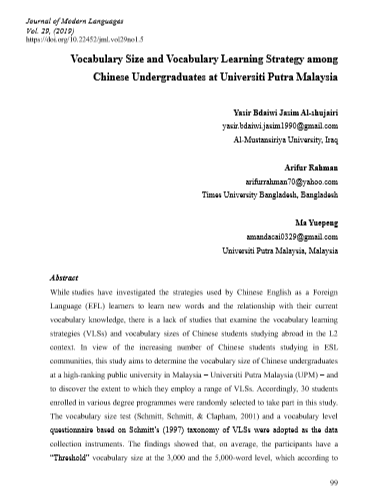Vocabulary size and vocabulary learning strategy usage among Chinese undergraduates at Universiti Putra Malaysia
Main Article Content
Abstract
While studies have investigated the strategies used by Chinese English as a Foreign Language (EFL) learners to learn new words and the relationship with their current vocabulary knowledge, there is a lack of studies that examine the vocabulary learning strategies (VLSs) and vocabulary sizes of Chinese students studying abroad in the L2 context. In view of the increasing number of Chinese students studying in ESL communities, this study aims to determine the vocabulary size of Chinese undergraduates at a high-ranking public university in Malaysia – Universiti Putra Malaysia (UPM) – and to discover the extent to which they employ a range of VLSs. Accordingly, 30 students enrolled in various degree programmes were randomly selected to take part in this study. The vocabulary size test (Schmitt, Schmitt, & Clapham, 2001) and a vocabulary level questionnaire based on Schmitt’s (1997) taxonomy of VLSs were adopted as the data collection instruments. The findings showed that, on average, the participants have a “Threshold” vocabulary size at the 3,000 and the 5,000-word level, which according to Schmitt et al. (2001) enables learners in reading different authentic texts. However, Nation and Beglar (2007), Schmitt and Schmitt (2014), Coxhead, Nation, and Sim (2015) suggested that non-native undergraduates studying in English as a medium of instruction (EMI) colleges and universities require a vocabulary size of 9,000-word family. The findings of this research raised important concerns that require our attention on the Chinese undergraduates studying in EMI context are at risk due to their insufficient vocabulary size. Moreover, results also revealed that the participants used direct VLSs such as memory and cognitive strategies the most. Taken together, the findings of this research provide insights into undergraduates’ overall inadequate vocabulary size, and how different VLSs were employed to cope with academic demands.

